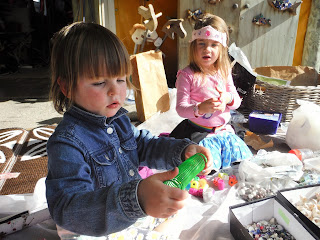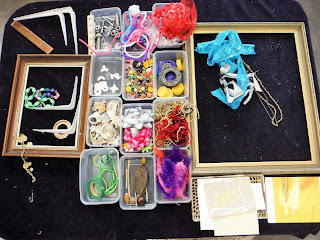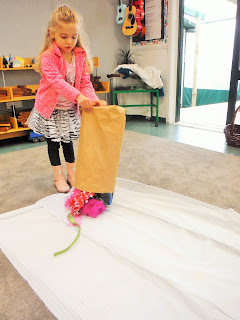At the end of
last term we sent home ‘Treasure Bags’ with our children. A humble brown paper
ready to fill with beautiful and interesting bits and bobs. We gave the
families some ideas as to what they could put in the bags. The book, ‘Beautiful
Stuff – Learning with Found Materials’ by Weisman Topal and Gandihi (1999), was our
inspiration for this idea. It is full of great provocations and gives some
lovely notions of ways that ‘stuff’ can be utilised to support children’s
thinking, creativity and learning. The introduction to this book powerfully
states that, “To a young child, the world is full of materials to touch,
discover, and explore. To find, collect, sort, and use materials is to embark
on a special kind of adventure. For adults, gathering materials means rediscovering
the richness and beauty in natural, unexpected, and recyclable objects that are
all around us, but not often noticed.”
After the
term break we were all excited to see what was going to come back in the bags. The
response from our children and their families was immense, filling up our benches and office shelves with many, many bags. The children were excited about
opening their treasure bags, bursting at the seams to show their friends and
teachers all the wonderful things that they had found for their individual
bags.
Usually we
would do a big grand opening at a group time, however this wasn’t able to
happen for numerous reasons so over the past few weeks we have been opening the
bags in small groups. The delight that was shared amongst the children as they
got to up-turn their bags and tip out their treasures was just so lovely. They
were given time to look at, play with and talk about what they had within their
contents. The other children who were observing also had a chance to explore
their friend’s treasures. It was all very exciting! There was lots of dialogue
and debates around what objects were and where they may have come from.
“Oh, this is
mine. Oh, this is so sparkly. I love the pink flowers. I think it is from the
shop. It must be treasure.” (Mercia)
“Hey Zair.
This mine, mine monies (bottle lids). Don’t touch. I love my green flower. It’s
from my bag, my Mummy.” (Nethra)
My Nana is so
cleaver isn’t she because she did this treasure. Look I have a boongy thing. It
is like a snake.” (Kayla)
“I love all
my treasure bag stuff. You know I have heaps of ribbon. And you know that the
ribbon can be fun for cats. You could make a ribbon for your kitty. They love
chasing ribbon.” (Sam)
“Oh look,
this is so beautiful stuff. What are all these? Oh they are beads, I love the
beads. This is pretty fabric, I think they will make such beautiful stuff.” (Tamsyn)
“My Mum got
this here, I like my beads the best.” (Austin)
“It’s like a surprise
egg. I don’t know what this is. I want to play with it though!” (Kalani)
“This is an
old cushion – you can have it for some treasure!” (Oliver)
“These are
for paper, if you don’t want paper to get wet you put it in here. I got some of
this from my Nana and some from my house. This is the biggest treasure bag,
mine is the biggest, biggest, biggest one. Everyone else is the littlest,
littlest, littlest ones. It’s got stuff really like in it and I think we could
make a lot with all the beautiful things. There is heaps you can do with stuff!”
(Sienna)
“My favourite
is the buttons in my bag. Umm we can do making spider webs with the wire. I don’t
know where wire comes from by I know we have some at our house.” (Sadie)
“I like my
Nana’s house stuff and my flies I brought. We can use all this paper it for
cutting out pictures.” (Toby)
“I brought
lots of heavy things, we could make so many things with the things. Maybe we
could make presents for everyone!” (Ruby)
“You know my
Nan gave me lots of treasure for my bag. There is so many lovely necklace’s.
What do you think we can do with these? Maybe they can just make something
beautiful for kindergarten. And I have been sorting this pile of ribbons. There
are just so many, it’s a very big pile. This stuff would be great for glue
gunning or even wrapping the tui’s for our turning five birthdays at
kindergarten.” (Nyla)
“This shell
is from the sea, I got them with my Mum.” (Willa)
“Look, it’s
my magic beans! They are magic for kindy!” (Manaia)
"This is from my Granny's house and my house. I'm thinking I can make fishes and octopus's with these. This is going to be a surprise for you (wrapping some of the treasure in paper). Do you know what it might be?" (Aurelia)
"Sorting my stuff was quick, but I like sort my friends stuff. I don't know what some of it is, it is interesting to pick up and look at." (Amaya)
“Can I open
treasure? We can play with the treasure and hammer them.” (Ahmad)
Next the
children were asked to sort their treasures into groups. It was really
interesting watching how some children group their objects; specifically,
thoughtfully and methodically grouping things like lids, metal bits, ribbon,
shells, paper, wire, buttons, beads, seed pods and so on.
There is
something satisfying and enjoyable about sorting. It seems to be relaxing and filling
for both children and adults alike. It is also an activity that supports
different learning areas. Gordan (2001) acknowledges that, “Sorting objects or toys according to
size or colour helps children develop their intellect. These experiences are
not only fun, but are building blocks for later learning. Sorting, matching and
classifying are a means to academic learning in math, reading and science.”
After sorting
the materials and objects they were then transferred to our low table with
containers and frames. This became a space were children were encouraged to use
the found and recycled materials to create works of art in the frames. During this
process the children used their senses to explore the materials. Looking
closely at them, handling them, even smelling and mouthing the objects (though
the mouthing of the objects was discouraged). The objects made beautiful pieces
of art and the children who engaged in this activity did so with consideration
and purpose.
“I’m making
his face. What can I use for his eyes and what is this (holding a piece of ribbon)?
Oh, I think I need this in my picture, it can go round and round here.” (Pippa
L.)
Once a child
had finished making a picture in the frame they were then encouraged to sort
the objects back into the right containers so that others could come and enjoy
the activity after them. This sorting of the materials was once again really
enjoyed by the children.
“Children have a natural desire to make sense of their
world, to create order in a world that seems largely out of their control. For
that reason, sorting activities often attract children. In fact, many children
will start sorting things without even being taught.” (peacefulparenting.com)
Other materials have been utilised on our glue gun table, with Madison instigating a revamp of one of our fairy houses. She wanted to use her treasure bags contents to do this and happily let other children join her on the mission.
Some of the children have been very much engaged through out this whole experience, while other children have enjoyed certain aspects of it. Some of the children were eager to share the stories behind the treasures they had brought in while other children were more captivated by the sorting and then creating works of art with all the interesting objects. All in all the process and experience has been very valuable and interactive.
In the book (mentioned
above) that inspired this concept they use the found and recycled materials in
rich and meaningful ways, using them to explore children’s thinking, represent
their ideas and knowledge in very creative and flexible ways. This book is available
at kindergarten if any of our families would like to have a look to gain a
deeper understanding of the ideas behind the treasure bags.
We are so
thankful to have all these wonderful treasure bags and really appreciate that
we have some many wonderful families who jumped on board with the idea. All the
contents of these bags will eventually go into our kindergarten resources and
be enjoyed at many different activities. Open ended and interesting, the way
that these objects and materials can be used is exciting and we can’t wait to
see how they are utilised to support the children’s thinking and interests. I
feel that we are still at the beginning stages of seeing the full potential
that these treasures can bring to our children’s in terms of creating lots of
joy and learning opportunities. I will finish this blog post with another
lovely quote from Weisman Topal and Gandihi’s book about ways to think about
stuff.
“A Way of
Thinking- We think back to the beginning of this experience and realize that
bringing materials into the classroom and discovering their potential for
learning involves many of the same process skills used in math and science and
interpreting literature. It’s a way of thinking about things. It helps both
teachers and children become more aware of how they think. The experiences also
refines our aesthetic sensibilities, and gives both adults and children a frame
work for learning life skills.” (p. 98)
Till next
time,
Zair

































































3 comments:
What a fabulous post! I love the "Beautiful Stuff" book, used it with my ECE students. And now there is the current interest in "loose parts" -- what goes around comes around!
I teach a Yr 1 -2 class and am trying to teach learning through play. I found your blog very inspirational. I especially loved the links to thinking skills. Us Primary teachers sometimes get stuck thinking that academic concepts only belong to reading/writing and maths. Of course this is just not true.
Hi everyone . I have had a fabulous time looking at your cool blog. I especially loved your monarch butterfly information. We are learning more about butterflies and their habitats at the moment. It is very exciting to see that so many 'experts' are getting ready for 'big' school. Ka Pai! Ms King and I are looking forward to meeting our new students coming from Mairtown very soon. Maybe you could check out Horne blog too mrscrooks.blogspot.co.nz. See you soon
Mrs Crooks x
Post a Comment